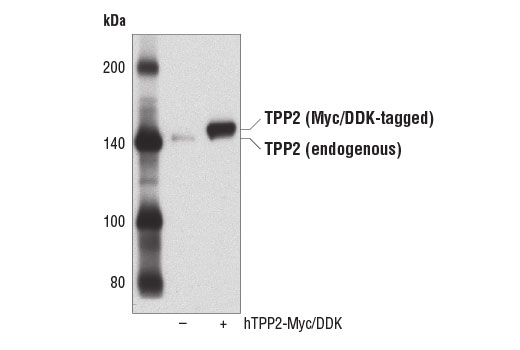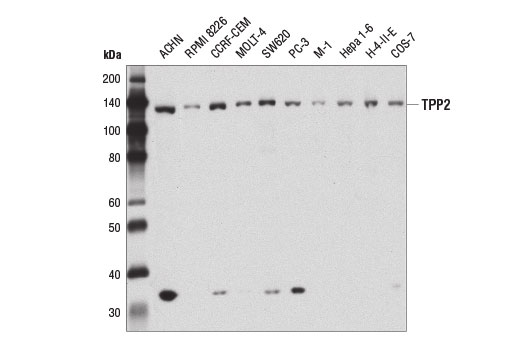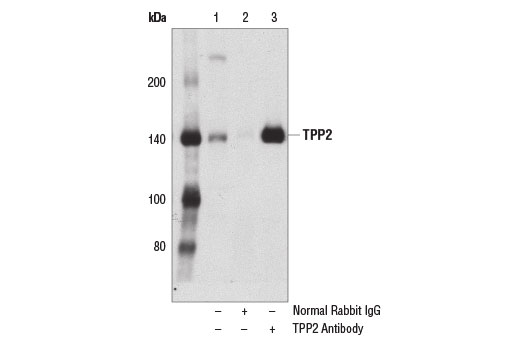WB, IP
H M R Mk
Endogenous
140
Rabbit
#P29144
7174
Product Information
Product Usage Information
| Application | Dilution |
|---|---|
| Western Blotting | 1:1000 |
| Immunoprecipitation | 1:100 |
Storage
Specificity / Sensitivity
Species Reactivity:
Human, Mouse, Rat, Monkey
Source / Purification
Polyclonal antibodies are produced by immunizing animals with a synthetic peptide corresponding to residues near the carboxy terminus of human TPP2 protein. Antibodies are purified by protein A and peptide affinity chromatography.
Background
Tripeptidyl-peptidase 2 (TPP2) is a well-conserved subtilisin-like amino peptidase that is expressed predominantly in the cytoplasmic compartment (1,2). The amino-terminal region of TPP2 harbors a catalytic triad that is characteristic of serine proteases and allows for TPP2 cleavage of tripeptides from the free amino terminus of oligopeptide substrates (3). TPP2 is a large (>5MDa) homooligomeric protease in which proteolytic activity is regulated by subunit oligomerization (4,5). While TPP2 plays a general role in amino acid homeostasis, research studies demonstrate that TPP2 is involved in MHC class I antigen presentation (6,7) and DNA-damage repair (8). TPP2 activity is required for the survival of Burkitt's lymphoma cells, suggesting a possible role for TPP2 in oncogenesis (9). Additional research studies show that TPP2 proteolytic activity is important for regulating lysosome abundance and glycolytic metabolism and that TPP2 deficiency leads to defects in adaptive immunity, innate immunity, and nervous system development (10).
- Tomkinson, B. (1999) Trends Biochem Sci 24, 355-9.
- Tomkinson, B. and Lindås, A.C. (2005) Int J Biochem Cell Biol 37, 1933-7.
- Hilbi, H. et al. (2002) Biochim Biophys Acta 1601, 149-54.
- Seyit, G. et al. (2006) J Biol Chem 281, 25723-33.
- Tomkinson, B. (2000) Arch Biochem Biophys 376, 275-80.
- Seifert, U. et al. (2003) Nat Immunol 4, 375-9.
- York, I.A. et al. (2006) J Immunol 177, 1434-43.
- Preta, G. et al. (2009) Biochem Biophys Res Commun 389, 575-9.
- Gavioli, R. et al. (2001) Nat Cell Biol 3, 283-8.
- Lu, W. et al. (2014) Cell 159, 1578-90.
Species Reactivity
Species reactivity is determined by testing in at least one approved application (e.g., western blot).
Western Blot Buffer
IMPORTANT: For western blots, incubate membrane with diluted primary antibody in 5% w/v BSA, 1X TBS, 0.1% Tween® 20 at 4°C with gentle shaking, overnight.
Applications Key
WB: Western Blotting IP: Immunoprecipitation
Cross-Reactivity Key
H: human M: mouse R: rat Hm: hamster Mk: monkey Vir: virus Mi: mink C: chicken Dm: D. melanogaster X: Xenopus Z: zebrafish B: bovine Dg: dog Pg: pig Sc: S. cerevisiae Ce: C. elegans Hr: horse GP: Guinea Pig Rab: rabbit All: all species expected
Trademarks and Patents
Limited Uses
Except as otherwise expressly agreed in a writing signed by a legally authorized representative of CST, the following terms apply to Products provided by CST, its affiliates or its distributors. Any Customer's terms and conditions that are in addition to, or different from, those contained herein, unless separately accepted in writing by a legally authorized representative of CST, are rejected and are of no force or effect.
Products are labeled with For Research Use Only or a similar labeling statement and have not been approved, cleared, or licensed by the FDA or other regulatory foreign or domestic entity, for any purpose. Customer shall not use any Product for any diagnostic or therapeutic purpose, or otherwise in any manner that conflicts with its labeling statement. Products sold or licensed by CST are provided for Customer as the end-user and solely for research and development uses. Any use of Product for diagnostic, prophylactic or therapeutic purposes, or any purchase of Product for resale (alone or as a component) or other commercial purpose, requires a separate license from CST. Customer shall (a) not sell, license, loan, donate or otherwise transfer or make available any Product to any third party, whether alone or in combination with other materials, or use the Products to manufacture any commercial products, (b) not copy, modify, reverse engineer, decompile, disassemble or otherwise attempt to discover the underlying structure or technology of the Products, or use the Products for the purpose of developing any products or services that would compete with CST products or services, (c) not alter or remove from the Products any trademarks, trade names, logos, patent or copyright notices or markings, (d) use the Products solely in accordance with CST Product Terms of Sale and any applicable documentation, and (e) comply with any license, terms of service or similar agreement with respect to any third party products or services used by Customer in connection with the Products.


